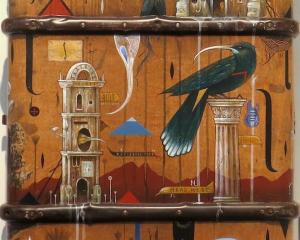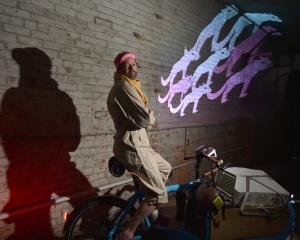Excavating through a box of what turned out to be icing sugar, giant jellied animals that artist Tim Barlow had made in the 1990s were re-discovered.
"I’d left it for the Dunedin Art School in 1994. It was a box of sweets, giant-sized. They were animals that were introduced pests. In the early ’90s they were wreaking havoc on the country — possums, stoats, rats that sort of thing. I’d been producing an ecological, environmental installation for my honours year and this was part of the exhibition."
That box was significant for two reasons — it led to the art school tracking down Barlow as part of its 150th celebrations search for alumni and it marked Barlow’s first foray into works with an environmental message, something he has continued since.
"I guess I’d been off the radar a bit."

After that first approach, came the idea for him to take part in the artist’s residency programme at the school. It just so happened Barlow had visited Dunedin last year, for the first time since he completed his honours degree, to research a new project.
"It was all very serendipitous. I thought this will give me the perfect opportunity to carry on my project."
It has also, thanks to Covid-19 delaying the residency, tied in nicely with this weekend’s "Mapping the Anthropocene in Dunedin — climate change, community and research in the creative arts" symposium and art exhibition, allowing him to present progress on his project.
The project is centred around lime production as an alternative to concrete production, which is a major contributor to CO2 emissions.

"Lime production has a fascinating history from early New Zealand colonial times going back thousands of years to the Egyptians, who used this beautiful product."
His research led him to lime kilns around the province, including on the Otago peninsula and in Central Otago.
Barlow, who lives on the Kapiti Coast, has been talking to artists, masons and heritage restorers trying to devise ways of creating and working with the product.
"I was interested in using it for artistic purposes, casting, fresco work, stucco work. They’ve all through history used lime but that technology has kind of been lost."
There is now a resurgence going on around the globe because it is a "very versatile, beautiful product that you can do lots with", he says.
"It is more lower carbon emission. What really interests me is that it can be done on the local level, so we’ve been trying down here to burn our own lime."

He is really interested in how lime could be used to empower local communities to work together rather than relying on big industry.
"Also, what is wonderful is that it can be recycled. In the Middle Ages they chopped up all the old Greek and Roman statues made out lime that they didn’t like and reburnt them. It fits into that idea of the circular economy as well. It doesn’t end up in the landfill."
There is a historical research part to Barlow’s project examining the use of lime in Otago and in Western civilisation, and there is another part in which he is engaging with local masons, artisans and the heritage industry.
He has been working with those involved in using lime for heritage restoration — such as Lawrie Forbes, Stuart Griffiths and Heritage New Zealand Conservation Adviser Otago-Southland Andrew Barsby — to develop ways to create and use lime.
"I love doing the lime burning, it’s fun making it ourselves. I’m not an office artist. To me lots of ideas come out during the process of making. The ideas develop as you go."
Forbes had bought a German lime mixer just before lockdown to help him with the restoration of the Dunedin Athenaeum.
Since coming to Dunedin, Barlow has been working on a proposal for a Central Otago sculpture park, by building full-scale samples based on the idea of a concrete fence post.
"It may sound very dull and mundane, but actually it has a very interesting history."
Through research he has discovered that the concrete fence post was developed by a construction foreman on the Waitaki Dam during the Great Depression after he put in pre-tensioned No8 wire to strengthen the post.
"Reportedly, that’s where the ‘No8 wire mentality’ came from."
He has been making the wooden moulds for his posts and prototypes to test ways of strengthening them.
"I’ve worked with a lot of moulds, silicone, latex and plaster, polyurethane. Most are quite toxic, so here I’m trying good old-fashioned wooden moulds."
But making lime cement is a challenge as it is more brittle than concrete so he, and others, are trying to find what additives have been used in the past to strengthen it.
"We’re producing it ourselves, burning it ourselves. We’re trying to find the holy grail of lime, which is making lime concrete as good as the Romans made."
This is the latest in a long line of environmental projects that Barlow has created over the years, all stemming from his honours project, which also included an installation The Still, which tapped into Dunedin’s Stuart St aquifer as a way to highlight the issue of the poor quality of the city’s drinking water.
"In ’94, that was all quite fresh and new in New Zealand and quite controversial. It was quite fun and playful. I had giant test tubes with dead possums in them. I had piles of malt and had it burning and smoking. I got actual brewing equipment that came out of Wilsons and made my own still."
He believes being a bit older when he went back to do his honours — he had completed his diploma in the mid-1980s — and being more aware of issues and legacy led to a change in direction.

"It has become a long-abiding interest in art: water and the community. I believe strongly in community empowerment over their own resources."
Before that, he specialised in welded sculpture, describing it as a cross between animal form and machine.
"It was more fantasy-based art. It was great having that skill base from my education at Otago Polytechnic."
Those skills led him to work in the film industry, creating props for Weta Workshops, and then into design and concept making for museums, such as his latest involvement in an installation for a new Chinese museum dedicated to Chinese medicine.
For the past 11 years, Barlow has concentrated mostly on his art practice and completed a PhD at Massey University, Wellington, in community-based art projects concerning issues to do with water in 2017.
Barlow is also known for his playful installations — such as The Public Fountain in Taupo, where people jumped up and down on a platform to make it explode in a fountain of water, and in Wainuiomata: reacting to a debate about the water supply for Wellington he created a "huge water fight in the middle of town".
Barlow along with other artists, academics and those involved in climate change issues will speak at the symposium this weekend, which aims to show a picture of "where we are as we learn to live with and act in the changing environment" and how artworks can help people become aware, contemplate and assess the issues.
Keynote addresses will be given by Emeritus Prof Khyla Russell (Otago Polytechnic) and Prof Huhana Smith (Massey).
Running alongside the symposium is the exhibition "The Complete Entanglement of Everything", in which Barlow will show progress on his work along with works from 46 other artists, including Jenna Packer, James Robinson, Barry Cleavin, Peter Nicholls, Scott Eady and Michele Beevors.













![... we all become all of these things [installation view] (2025), by Megan Brady.](https://www.odt.co.nz/sites/default/files/styles/odt_landscape_small_related_stories/public/story/2025/03/1_we_all_become_all_of_thes.jpg?itok=nicA_yAm)